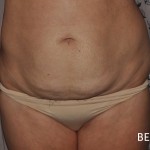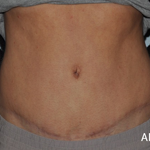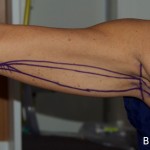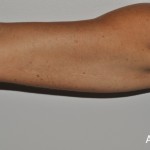ABDOMINOPLASTY / TUMMY TUCK
Loose skin, excess fat and lax musclse can sometimes limit your abdominal appearance no matter how many stomach exercises you do. A tummy tuck surgically removes redundant skin and unwanted fat from the abdominal area and may also tighten the muscles of the abdominal wall. The result is a sleeker profile and a tighter, flatter tummy.

Before*

After*
Abdominoplasty, known more commonly as a “tummy tuck”, is a major surgical procedure to remove excess skin and fat from the middle and lower abdomen and to tighten the muscles of the abdominal wall. The procedure can dramatically reduce the appearance of a protruding abdomen. But bear in mind, it does produce a permanent scar which, depending on the extent of the original problem and the surgery required to correct it, can extend from hip to hip.
The best candidates for abdominoplasty are men or women who are in relatively good shape but are bothered by a large fat deposit or loose abdominal skin that won’t respond to diet or exercise. The surgery is particularly helpful to women who, through multiple pregnancies, have stretched their abdominal muscles and skin beyond the point where they can return to normal. Loss of skin elasticity in older patients, which frequently occurs with slight obesity, can also be improved.
Patients who intend to lose a lot of weight should postpone the surgery. Also, women who plan future pregnancies should wait, as vertical muscles in the abdomen that are tightened during surgery can separate again during pregnancy If you have scarring from previous abdominal surgery, your doctor may recommend against abdominoplasty or may caution you that scars could be unusually prominent. Previous surgery e.g. gallbladder removal, may affect how the abdominoplasty is done.
Abdominoplasty can enhance your appearance and your self-confidence, but it won’t necessarily change your looks to match your ideal, or cause other people to treat you differently. Before you decide to have surgery, think carefully about your expectations and discuss them with your surgeon.
ALL SURGERY CARRIES SOME UNCERTAINTY AND RISK
Thousands of abdominoplasties are performed successfully each year. When done by a qualified plastic surgeon who is trained in body contouring, the results are generally quite positive. Nevertheless, there are always risks associated with surgery and specific complications associated with this procedure.
Postoperative complications such as infection and blood clots are rare, but can occur. Infection can be treated with drainage and antibiotics, but will prolong your hospital stay. You can minimise the risk of blood clots by moving around as soon after the surgery as possible.
Poor healing, which results in conspicuous scars, may necessitate a second operation. Smokers should be advised to stop, as smoking may increase the risk of complications and delay healing.
You can reduce your risk of complications by closely following your surgeon’s instructions before and after the surgery, especially with regard to when and how you should resume physical activity.
During your initial consultation, I will evaluate your health, determine the extent of fat deposits in your abdominal region, and carefully assess your skin tone. Be sure to tell me if you smoke, and if you’re taking any medications, vitamins, or other drugs.
Be frank in discussing your expectations with me. I will discuss and offer you alternatives, and the risks and limitations of each.
If for example, your fat deposits are limited to the area below the navel, you may require a less complex procedure called a partial abdominoplasty, also known as a mini-tummy tuck, which can often be performed on a daycase basis. You may, on the other hand, benefit more from partial or complete abdominoplasty done in conjunction with liposuction to remove fat deposits from the hips, for a better body contour, or maybe liposuction alone would create the best result.
I will work with you to recommend the procedure that is right for you and will come closest to producing the desired body contour.
I will give you specific instructions on how to prepare for surgery including taking or avoiding certain vitamins and medications.
Avoid overexposure to the sun before surgery, especially to your abdomen, and do not go on a stringent diet, as both can inhibit your ability to heal. If you develop a cold or infection of any kind, your surgery will probably be postponed.
You should arrange for someone to drive you home after your surgery, and to help you out after you leave the hospital, if needed.
For more details and information on pre-operative instructions use this link.
Abdominoplasty is generally done in a hospital, as an inpatient procedure. The surgery itself usually takes three to four hours, but may take longer in some cases. You can expect to remain in the hospital for up to five days.
Abdominoplasty is nearly always performed under general anaesthesia. You’ll be asleep through the entire operation.
Complete abdominoplasty usually takes three to four hours, depending on the extent of work required. Partial abdominoplasty may take an hour or two.
Most commonly, a long incision will be made from hipbone to hipbone, just above the pubic area. A circular incision is made to free the navel from surrounding tissue. With partial abdominoplasty, the incision is much shorter and the navel may not be moved, although it may be stretched as the skin is tightened and stitched.
The skin from the abdominal wall is then separated all the way up to your ribs and a large skin flap is lifted to reveal the vertical muscles in your abdomen. These muscles are tightened by pulling them close together and stitching them into their new position. This provides a firmer abdominal wall and narrows the waistline.
The skin flap is then stretched down and the extra skin is removed. A new hole is cut for your navel which is then stitched in place. Finally, the incisions will be stitched, dressings will be applied, and a temporary tube may be inserted to drain excess fluid from the surgical site for a few days.
In partial abdominoplasty, the skin is separated only between the incision line and the navel. This skin flap is stretched down, the excess is removed, and the flap is stitched back into place.
For the first few days, your abdomen will probably be swollen and you’re likely to feel some pain and discomfort which can be controlled by medication. Depending on the extent of the surgery, you may be discharged within a few hours or you may have to remain hospitalised for up to three days.
Dissolving stitches are generally used. Occasionally the skin stitches around the umbilicus will need to be removed at 8 – 10 days. The dressing on your incision may be replaced by a support garment. And though you may not be able to stand straight at first, you should start walking as soon as possible.
For further information please read the post operative instructions and if you have further questions my staff or I are available to talk to you should you have any concerns.
It may take you weeks or months to feel like your old self again. If you start out in top physical condition with strong abdominal muscles, recovery from abdominoplasty will be much faster. Some people return to work after two weeks, while others take three or four weeks to rest and recuperate.
Exercise will help you heal better. Even people who have never exercised before should begin an exercise program to reduce swelling, lower the chance of blood clots, and tone muscles. Vigorous exercise, however, should be avoided until you can do it comfortably.
Massage is highly recommended to improve lymphatic drainage, lessen swelling and reduce discomfort.
Your scar may actually appear to worsen during the first three to six months as they heal, but this is normal. Expect it to take nine months to a year before your scars flatten out and lighten in colour. While they’ll never disappear completely, abdominal scars will not show under most clothing, even under bathing suits.
Abdominoplasty, whether partial or complete, produces excellent results for patients with weakened abdominal muscles or excess skin. And in most cases, the results are long lasting, if you follow a balanced diet and exercise regularly.
If you’re realistic in your expectations and prepared for the consequences of a permanent scar and a lengthy recovery period, abdominoplasty may be just the answer for you.
If you would like to talk to us about your requirements please do contact us at your convenience.
BRACHIAPLASTY / ARM SURGERY
Brachiaplasty is a surgical procedure to remove excess skin and fat from the upper arms. This surgery can help those who have been left with excess skin following weight loss through diet and exercise, or following successful weight loss surgery. Surgery is not a weight loss treatment. If you plan to do lose more weight, then it is advisable to do so before having a Brachiaplasty. The results of Brachiaplasty can be long lasting, providing you maintain a healthy weight.

Before*

After*
Armlift surgery is usually performed under a general anaesthetic and you may need to stay in hospital one night. You will also need to plan time off work so that you can relax and recover at home.
Your surgeon will make appropriate incisions on the inner/under surfaces of your arm between your elbow and armpit. Excess skin and fat are removed and the remaining skin is stretched and stitched back together. There will be some visible scarring and this will be discussed with you before your operation.
Following surgery you may have drainage tubes in your arms that are in place to drain away any excess fluid. These are removed before you are discharged home. You will have wound dressings and a supportive compression garment in place. Mr Lofts will advise you as to how long you will be required to wear your supportive compression garment and whether it is to be worn day and night. At your post-operative follow-up appointment your surgeon will assess your progress and give advice on when you can resume your normal activities.
For further information please read the post operative instructions and if you have further questions my staff or I are available to talk to you should you have any concerns.
After a Brachiaplasty you are likely to have some discomfort, swelling, bruising, and pain or tenderness in your arms. These are temporary and should subside after the first few weeks. You will be left with visible scars following your surgery. Initially they will be red and slightly raised, but they will gradually soften and fade over time.
